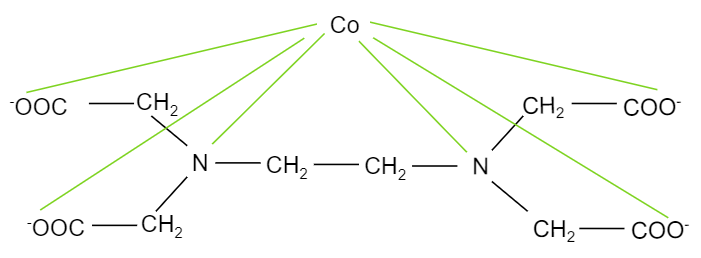
$EDT{{A}^{4-}}$ is ethylene diamine tetraacetate ion. The total number of $-N-Co-O$ bond angles in ${{[Co(EDTA)]}^{-}}$ complex ion is:
Answer
474k+ views
Hint: To get the total number of bond angles, first try to draw the chemical structure of the ethylene diamine tetraacetate ion and then see what structure it gives when it is treated with cobalt atoms. Draw the chemical structure of the complex formed, then you will get an idea about the number of bond angles present in the complex.
Complete step by step answer:
So, before proceeding to find the answer, let us know about ethylene diamine tetraacetate, in short referred to as EDTA.
So, EDTA is a hexadentate ligand, which implies that it binds multiple (six) times. It binds twice at the nitrogen and four at the oxygen atoms. It has an atomic structure a lot like a claw. The chemical structure of ethylene diamine tetraacetate ion i.e. $EDT{{A}^{4-}}$ is shown in the figure below:

When ethylene diamine tetraacetate ion is treated with cobalt element, it forms a complex, ${{[Co(EDTA)]}^{-}}$ where, cobalt binds with two nitrogen atoms and four oxygen ions present in the EDTA structure. The structure of the complex is shown below:

The oxygen atoms having negative charges and the two nitrogen atoms will be donating electrons forming bonds with cobalt. So, we can see that, in the complex, each nitrogen has four $-N-Co-O$ bond angles. And there are two nitrogen atoms bonded with cobalt. So, the total number of $-N-Co-O$ bond angles will be eight.
Hence, the total number of $-N-Co-O$ bond angles in ${{[Co(EDTA)]}^{-}}$ complex ion is eight.
Note: Metal analysis can be done by using the process of titration of the ethylene diamine tetraacetate and a metal where metal ion acts as the indicator. One of the most famous and most common uses of EDTA is to determine the hardness of the water.
Complete step by step answer:
So, before proceeding to find the answer, let us know about ethylene diamine tetraacetate, in short referred to as EDTA.
So, EDTA is a hexadentate ligand, which implies that it binds multiple (six) times. It binds twice at the nitrogen and four at the oxygen atoms. It has an atomic structure a lot like a claw. The chemical structure of ethylene diamine tetraacetate ion i.e. $EDT{{A}^{4-}}$ is shown in the figure below:

When ethylene diamine tetraacetate ion is treated with cobalt element, it forms a complex, ${{[Co(EDTA)]}^{-}}$ where, cobalt binds with two nitrogen atoms and four oxygen ions present in the EDTA structure. The structure of the complex is shown below:

The oxygen atoms having negative charges and the two nitrogen atoms will be donating electrons forming bonds with cobalt. So, we can see that, in the complex, each nitrogen has four $-N-Co-O$ bond angles. And there are two nitrogen atoms bonded with cobalt. So, the total number of $-N-Co-O$ bond angles will be eight.
Hence, the total number of $-N-Co-O$ bond angles in ${{[Co(EDTA)]}^{-}}$ complex ion is eight.
Note: Metal analysis can be done by using the process of titration of the ethylene diamine tetraacetate and a metal where metal ion acts as the indicator. One of the most famous and most common uses of EDTA is to determine the hardness of the water.
Recently Updated Pages
Master Class 11 Economics: Engaging Questions & Answers for Success

Master Class 11 Business Studies: Engaging Questions & Answers for Success

Master Class 11 Accountancy: Engaging Questions & Answers for Success

The correct geometry and hybridization for XeF4 are class 11 chemistry CBSE

Water softening by Clarks process uses ACalcium bicarbonate class 11 chemistry CBSE

With reference to graphite and diamond which of the class 11 chemistry CBSE

Trending doubts
What are the elders in Goa nostalgic about class 11 social science CBSE

Formaldehyde at room temperature is ALiquid BGas CSolid class 11 chemistry CBSE

Define least count of vernier callipers How do you class 11 physics CBSE

Distinguish between Mitosis and Meiosis class 11 biology CBSE

Why are forests affected by wars class 11 social science CBSE

Explain zero factorial class 11 maths CBSE




